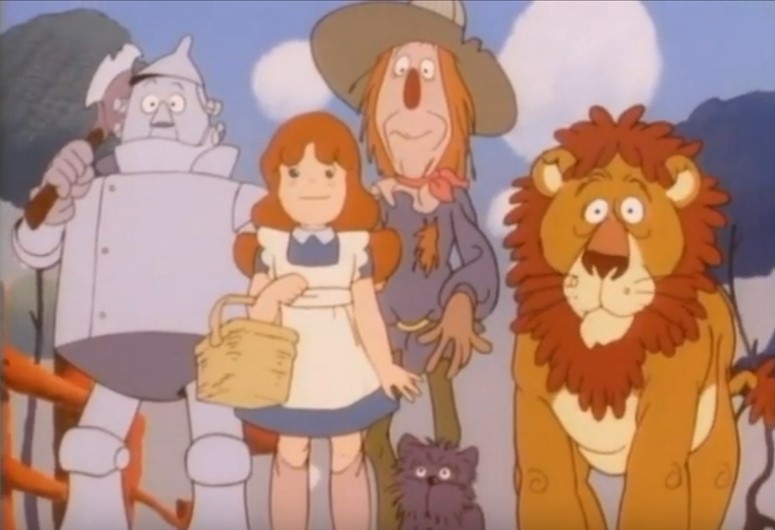The Wonderful Wizard of Oz (or Ozu no Mahōtsukai) is a Japanese anime released in 1986. Alongside The Wizard of Oz and Journey Back to Oz, the anime was one of my first introductions to the Ozian universe. Consisting of fifty-two episodes, the anime adapts four Oz books in a very whimsical manner. Another faithful adaptation to the books, the anime is a light-hearted series, with simple character designs, but plenty of charm.
Airing on TV Tokyo, the series had Akira Miyazaki as a head writer, previously writing the 1982 Japanese film adaption of the first book. The character designs and overall tone resemble that of Nippon Animation’s World Masterpiece Theatre, which director Hiroshi Saitō and character designer Shūichi Seki both worked on. The English dub was produced by HBO, featuring Margot Kidder (aka Lois Lane in the Superman films) as the narrator, whilst The Parachutes provided the series’ songs.
The anime is split into four arcs, each based on a different book. Characters and events commonly cut out of other adaptations are included, such as the Kalidahs, the Hammerheads, and Princess Ozma being transformed into Tip. On the other hand, it downplays the more gruesome and darker moments of the books. For example, Princess Langwidere, who could interchange her head for others, instead swaps personality-altering hats. Violence is often implied, or becomes more fantastical to avoid characters dying, save the wicked witches.
Dorothy is the central character, played by Morgan Hallett. Though sharing the innocence and vulnerability of her fellow incarnations, Hallett’s version is temperamental, outspoken, and is unstoppable if she puts her mind to something. Two episodes are dedicated to Dorothy relentlessly chasing down a defiant Ozma to teach her princess lessons. Ozma or Tip is a major character, voiced by Steven Bednarski, better known today as a historian. Tip serves as the co-protagonist n the second arc, being mischievous but thoughtful. Upon becoming Ozma, the character actually rebels against her own duties, acting bratty and petulant, until realising the responsibilities she carries.
The large supporting cast are all distinct in both designs and personality. The Scarecrow (Richard Dumont), the Tin Man (George Morris) and the Cowardly Lion (Neil Shee) all serve as foils to Dorothy. Though all gentle and kind, each has their own ongoing character arcs. The Wicked Witch of the West is rather unmemorable in this version compared to later villains. Glinda (Barbara Poggemiller) is meant to be benevolent, but frankly, she comes off as sinister, much like her 1939 counterpart. In the second arc, she literally brainwashes Mombi into declaring fealty to Ozma, before laughing triumphantly at her own power.
The Wizard of Oz (Vlasta Vràna) is a sympathetic character, though has a darker edge to him. There is a pivotal scene where Dorothy reunites with him in Kansas, but he advises her to stay quiet about Oz, or she will be branded as mad. This shakes Dorothy’s view of the Wizard, leaving her depressed and questioning her own beliefs in Oz. By far, the best character is Mombi (Kathleen Fee), a grouchy but inept old witch, who becomes powerhungry when exposed to greater magic. Her relationships with both Tip and the ditzy, would-be conqueror General Jinjur (Jane Woods) are highlights of the anime.
The third arc introduced the Nome King (Rob Roy) as the main antagonist. Rather than being a menacing rock monster like in Return to Oz, he is portrayed a gnome-like manbaby. The Nomes aren’t particularly menacing, though the King’s minions are fun, like the conniving Lord Kaliko (Arthur Grosser) and General Guph (Dean Hagopian). One of the few rare moments of horror occurs when the heroes participate in the King’s guessing game to find the captured Prince of Ev. If they touch any of the ornaments in the King’s palace, their bodies melt before transforming into an object. The Nomes become the main antagonists for the rest of the anime, plotting to conquer the Emerald City.
Throughout the anime, the tone remains often light and perky, though has the occasional frightening or dark moment. This eternal sense of whimsy is what makes The Wonderful Wizard of Oz a delightful show, remaining one of my favourite versions of Oz.
Have you seen the 1986 anime and what are your thoughts on it? How faithful is it to the books? Leave a comment below, or on our Twitter feed.


Leave a Comment